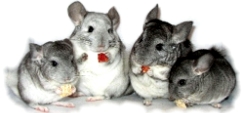The 3 year olds have been together and are opposite gender or are they all new and have only been together during supervised introduction attempts? Most of the time you don't notice a female is in heat or pretty much any other sign. You have to be around your chinchillas a lot or be randomly lucky to either see the male trying to breed or find the mucous plug the females have. Never seen one. I have seen mine attempting to breed on 2 occasions and I'm home all day.
Males raise kits fine but if they are left in the cage they will breed the female again and you will have very close together litters. This is bad for the health of the female. Also like GrayRodent said it's not really the most responsible thing to breed chinchillas with no pedigree, not knowing any health problems in their relatives, and not knowing if the chins have good characteristics. After health you want to breed for the proper shape, coat type, and color. Getting a good coat on them is what makes a chinchilla.

 Author
Topic: New discovery.. (Read 2380 times)
Author
Topic: New discovery.. (Read 2380 times)




